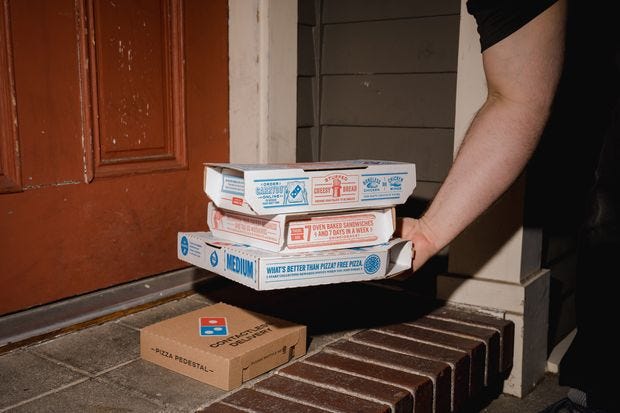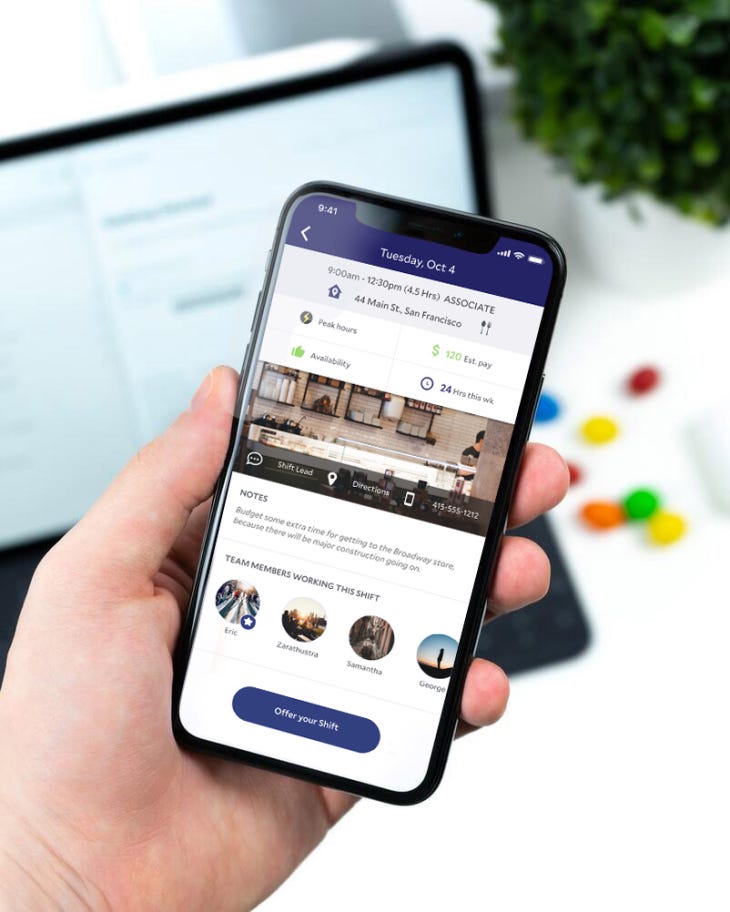America at Hunger's Edge
Tippets by Taps #147: Food insecurity, Domino's dominates, Reed Hasting's new book, Legion's Series B and more. Enjoy (and happy Labor Day!)
Happy Labor Day from a very hot Bay Area where the high temp I have registered is 113°F and evacuation bags are packed just in case fires in the area force my family and me to evacuate! I hope your weekend has been restful and you’ve managed to take some time off. To the new Tippets readers who have subscribed over the past week, a very warm welcome (pun intended)! If you're reading this, not yet subscribed, and looking to receiving Tippets alongside the other similarly curious, intelligent people who've already subscribed, click below! 😄
America at Hunger’s Edge
Last week the New York Times put out an interactive photographic essay feature, examining the impact of COVID on those struggling with food insecurity.
Food insecurity is as much about the threat of deprivation as it is about deprivation itself: A food-insecure life means a life lived in fear of hunger, and the psychological toll that takes. Like many hardships, this burden falls disproportionately on Black and Hispanic families, who are almost twice as likely to experience food insecurity as white families.
It's a moving piece that served as an important reminder of my good fortune and privilege. Following the pandemic, the uncertainty facing over 20 million families adds an unimaginable level of stress, particularly to those already spending so much of their incomes on food. COVID is particularly heartbreaking when you consider the more than 18 million children impacted by school closures, as schools have historically been a reliable source of provided lunches.
“Oh, Mommy, we’re going to have food tonight,” they would tell her. “We’re not going to go to sleep with no food in our tummy.”
The accompanying essay, How Hunger Persists in a Rich Country Like America by Adrian Nicole LeBlanc, is also a great read into the subject.
If you’re able, I urge you to consider donating to Feeding America, a hunger relief non-profit that operates food banks around the United States.

Most Businesses Were Unprepared for Covid-19. Domino’s Delivered.
We’ve talked before about the distinct advantage large, well-capitalized companies have had over the competition during COVID. Those who invested behind trends - digital experiences, global supply chains, millennial brand development - prior to COVID have been able to press the advantage. Domino’s Pizza is a great example.
More than 15,000 restaurants have failed during the coronavirus pandemic, according to statistics from Yelp’s website. NPC International (a Pizza Hut and Wendy’s franchisee) and California Pizza Kitchen have filed for bankruptcy protection. Sales at stores open at least a year plummeted 37% in the second quarter from a year earlier according to Black Box Intelligence, which tracks the industry.
Domino’s, however, didn’t have those problems. Its U.S. sales in the same period leapt 16%.
Domino’s has redefined what success looks like for QSR. From fixing potholes to pizza insurance, the pizza chain has been ahead of the curve for a long time.
Since 2007, the range of channels through which to order digitally has steadily expanded: via desktop, then mobile, apps for the iPhone, iPod Touch and Android, Samsung televisions, Pebble, Android and Apple smartwatches, Twitter and text with a pizza emoji, Amazon Echo, Google Home, Slack, and Facebook Messenger.
The typical quick-service chain does between 5-10% of their orders digitally. Dominos’s did 65% of their orders digitally last year. This year that number is up to 75%. Following COVID, they’ve gone both low-tech and high tech, with a foldout “foldout “pizza pedestal” on which drivers can place the pie to avoid contact with customers” and “driverless pizza delivery vehicles, which would remove the possibility of any contact with a human being.” A great case study on building business resiliency through a relentless focus on the customer experience.

Netflix’s Reed Hastings Conquered Hollywood With a PowerPoint Presentation
Reed Hastings has built Netflix into a household name. His company has redefined what it means to be a media company, forever changing the nature of content and delivery. However, some (including Sheryl Sandberg) would argue that the most important thing that might have come out of Netflix is the 127-page Culture Deck that was released in 2009 and has since accumulated over 20 million views. It defined a new approach to recruiting, hiring, and talent management, and helped propel Netflix into the stratosphere. For more on the Netflix culture, you can read my notes on Patty McCord’s (Netflix’s former Chief Talent Officer) book, Powerful here.
The approach boiled down to a simple idea: Hire the very best people and get out of their way. Netflix employees are paid far more than they would earn at almost any other company, receiving unlimited vacation, generous parental leave and no official limit on expenses. The company’s decentralized decision-making lets people take big swings without approval from above. Hastings is fond of talking about how few decisions he makes, suggesting that his job is little more than cutting ribbons and kissing babies.
Now, Hastings is writing a book about building the company, due out on September 8th, about “what he says is the real key to Netflix’s success: its culture”. Netflix, meanwhile, is trying to map its future without Hastings (who is currently playing “I’m Going to Retire Soon Bingo” having written a book and also just promoted a lieutenant to the role of Co-CEO).
As Netflix has grown, what started as a technology company led by engineers has morphed into an entertainment company led by thousands of people trained in Hollywood studios. The two sides have often disagreed, including over how best to market Netflix’s shows and movies. (The engineers prefer to only use algorithms to target an audience, while Hollywood executives like billboards and parties.) Yet Hastings says any lingering tension has been resolved in Los Angeles’s favor. The company now spends two-thirds of its money on content, and has more employees in Los Angeles than Silicon Valley.
I for one am looking forward to his forthcoming book’s release, and will share notes as soon as I am done!

Legion raises $22 million to automate workforce scheduling
[Author’s note: I’m the SVP of Strategy and Business Operations at Legion. All views expressed here are my own.]
A bit of self-serving promotion, but what the heck. This week we at Legion announced our $22M Series B. We’ve built AI-powered workforce management software with the goal of maximizing labor efficiency and employee engagement simultaneously. When I joined Legion last December, I wrote the following:
82 million people are hourly workers in the United States — almost 60 percent of the U.S. workforce. These people are the driving force behind many of our largest industries, including food & beverage, retail, and hospitality. Unfortunately, these employees have often been viewed as a commodity by employers — a cost line item that needs to be optimized as much as possible which creates challenges for both employees and employers. Workers don’t have flexibility or predictability in their schedule, which leads to low worker satisfaction and high churn. The combination of worker churn, the high cost of worker replacement, and often confusing compliance requirements put incredible pressure on operations and H.R. teams who, in turn, try to reduce their costs even further, and the vicious cycle continues. In our modern, Uberized times, employees are looking for predictable schedules, gig-like flexibility, and mobile-first technology that lets them schedule meaningful work. They shouldn’t need to haggle on a weekly basis with their managers. At the same time, managers and operations teams shouldn’t have to use Excel spreadsheets or bloated, on-premise technology solutions to figure out the right combination of employees required to operate their stores successfully. As the nature of work continues to change, the nature of the employee management and employee engagement needs to transition with it. Legion’s mission is to enable this transition.
In the 10 months since I’ve been at the company, I’ve only been more inspired by the team and the opportunity ahead. This week Techcrunch commented:
Legion is designed to help employers better manage their hourly workforces by automating certain decisions, like how much labor to deploy to meet the needs of the company and when to schedule workers. Taking into account demand forecasting, labor optimization and the preferences of employees, Legion then generates a schedule that “ensures employees are able to work when they prefer to work,” Legion CEO Sanish Mondkar told TechCrunch. “These are all important problems to solve in the overall puzzle of labor management.”
Now more than ever, companies and their employees need better technology to help ensure a safe and accommodating re-opening. We’re hiring, so if you or someone you know is interested in working on a problem that impacts 2.3B people globally let me know!

Amazon Drivers Are Hanging Smartphones in Trees to Get More Work
Talk about clever hacks.
Someone places several devices in a tree located close to the station where deliveries originate. Drivers in on the plot then sync their own phones with the ones in the tree and wait nearby for an order pickup. The reason for the odd placement, according to experts and people with direct knowledge of Amazon’s operations, is to take advantage of the handsets’ proximity to the station, combined with software that constantly monitors Amazon’s dispatch network, to get a split-second jump on competing drivers.
Much the way milliseconds can mean millions to hedge funds using robotraders, a smartphone perched in a tree can be the key to getting a $15 delivery route before someone else.
The phones in trees seem to serve as master devices that dispatch routes to multiple nearby drivers in on the plot, according to drivers who have observed the process. They believe an unidentified person or entity is acting as an intermediary between Amazon and the drivers and charging drivers to secure more routes, which is against Amazon’s policies.

Quote I’m thinking about: “Take rest. A field that has rested gives a bountiful crop.” – Ovid
If you have feedback on anything mentioned above or have interesting links/papers/books that you think would be worth sharing in future issues of Tippets, please reach out! Click the feedback link below, reply to this email, or DM me on Twitter at @taps.



